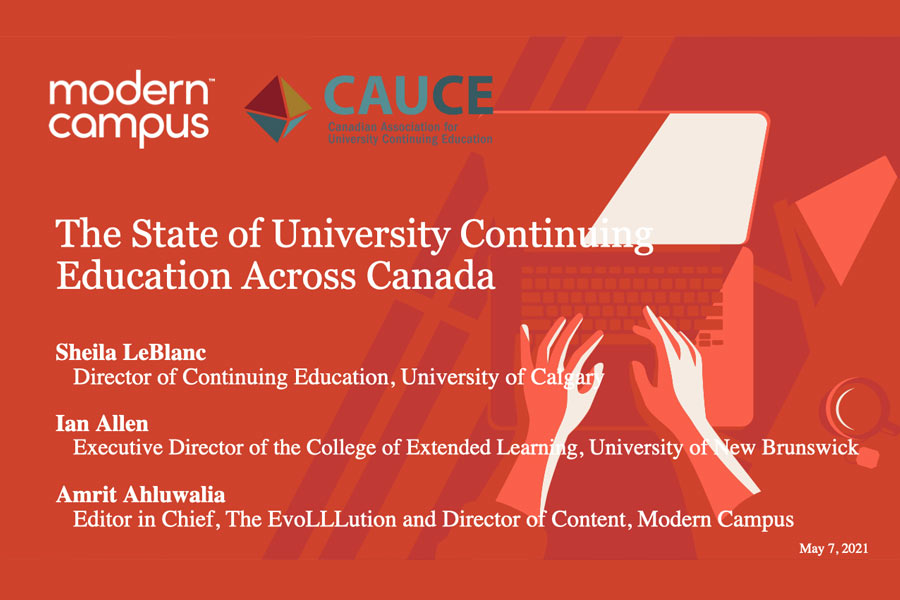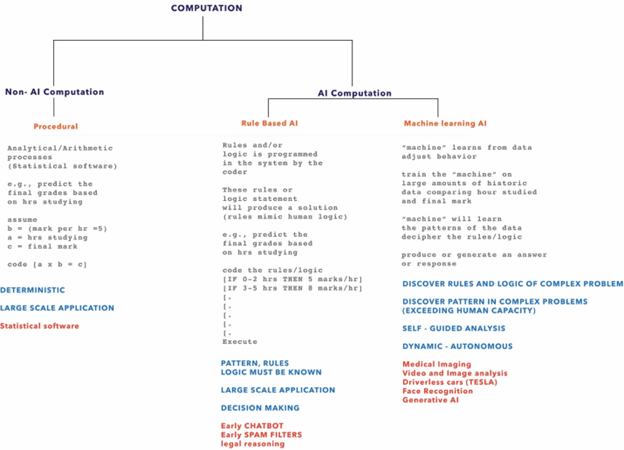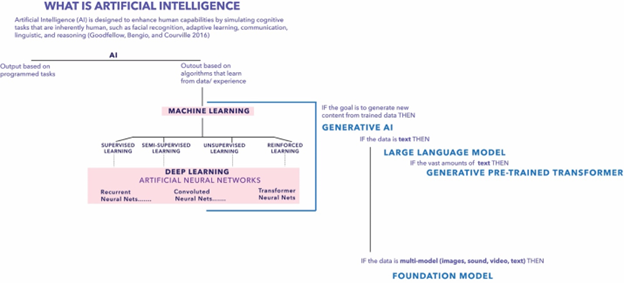
LIFELONG LEARNING WEBINAR SERIES 2023-2024
AI Unleashed: Deciphering the Impact of Generative Artificial Intelligence on Lifelong Learning
A series of webinars exploring the potential and challenges of emerging generative artificial intelligence tools in the realm of lifelong learning. From understanding AI's transformative influence on higher education to unearthing emergent AI tools for learners, each hour-long session will facilitate in-depth conversations with experts. The series wraps up with a comprehensive panel discussion on the future of AI in lifelong education.
Host

Karen Woloschuk, Executive Director, Business & Administration, UM Extended Education
Karen will host all of the webinars in this series.
Previous webinars
Lifelong Learning Webinar Series 2023-2024
AI and the Age of Augmentation: A Panel Discussion on the Future of AI in Lifelong Education
Description
This webinar was the finale of our AI webinar series, an enlightening expedition into the dynamic and sometimes challenging realm of AI in the higher educational landscape. With Kelly Shiohira, Ray Schroeder, Len Gonick and Rod Lastra, this session focused on how higher education can revolutionize teaching and learning with performative generative AI, with a reflective overview of the past year as well as a visionary forecast of future possibilities.
Watch the video
Featuring
Kelly Shiohira, Director for the Global Science of Learning Education Network
Ray Schroeder, Senior Fellow at UPCEA, the Online and Professional Education Association, and Professor Emeritus at University of Illinois Springfield (UIS)
Lev Gonick, CIO at Arizona State University (ASU)
Rod Lastra, lifelong learning professional, UM Extended Education
Lifelong Learning Webinar Series 2023-2024
Unpacking the Ethical Implications of Bias and Data Use in Generative AI Models
Description
This webinar with Safiya Nobel and Cecil Rosner delved into the ethics and challenges of generative AI, focusing on the biases inherent in the data and information it's trained on. It explored the complexities and ethical considerations of AI model training, underscored by concerns such as those raised in the recent New York Times lawsuit against AI companies over the use of published articles in training AI models.
LIVE EVENT - NOT RECORDED
Featuring
Safiya Nobel, author of Algorithms of Oppression
Cecil Rosner, author of Manipulating the Message - How Powerful Forces Shape the News
Rod Lastra, lifelong learning professional, UM Extended Education
Presentation notes
Lifelong Learning Webinar Series 2023-2024
The AI Horizon of Higher Education: emergent tools and policy considerations
Description
This webinar with Mike Sharples delved into the latest advancements in generative AI tools and their potential benefits for lifelong learners. It offered an in-depth exploration of how generative AI tools can be harnessed for educational purposes. The conversation focused on AI policy and regulations arising in the UK and EU and their relevance in Canada.
Watch the video
Featuring
Mike Sharples, Emeritus Professor of Educational Technology at The Open University, UK
Rod Lastra, lifelong learning professional, UM Extended Education
Lifelong Learning Webinar Series 2023-2024
AI and the Academy: Transformative Learning in Higher Education – a conversation with Sal Khan
Description
This webinar featured Sal Khan, CEO and founder of Khan Academy. It explored the transformative impact of generative AI on education, with a focus on higher education and the ways in which AI, especially tools like Khanmigo, can revolutionize learning experiences.
LIVE EVENT - NOT RECORDED
Featuring
Sal Khan, CEO and founder of Khan Academy
Rod Lastra, UM Extended Education
Lifelong Learning Webinar Series 2023-2024
Lifelong Learning and Generative AI: Unpacking ChatGPT’s Potential
Description
Ray Schroeder, distinguished educator and Senior Fellow at UPCEA, the Online and Professional Education Association, joined Rod Lastra (Acting Dean, UM Extended Education) for a conversation about the revolutionary world of generative AI, with a special focus on the transformative potential of ChatGPT.
Watch the video
Presentation notes
Recommended readings
Wolfram, Stephen, What is ChatGPT Doing… and Why Does It Work?
Read Ray's Online: Trending articles on generative AI in higher education
Lifelong Learning Webinar Series 2023-2024
Lifelong Education in the Age of Artificial Intelligence
Description
In this webinar, Kelly Shiohira, Executive Manager: Research and Data Ecosystems at JET Education Services, joined Rod Lastra, Acting Dean, UM Extended Education for a conversation about Lifelong Learning in the Age of Artificial Intelligence. Kelly shared her thoughts on how AI has influenced higher education and how we should respond to the potential future implications.
Watch the video
Diagrams from the discussion
The Difference between Non-Computational AI, Rule based AI and Machine Learning
The architecture of a generative AI model
Recommended Readings
Artificial Intelligence (AI) and Computers
Turing, A. (1950). Computing machinery and intelligence. Mind A Quarterly Review of Psychology and Philosophy, 236, 433–460. https://doi.org/10.1093/mind/lix.236.433
Wooldridge, M. (2021). A brief history of artificial intelligence: what it is, where we are, and where we are going. Flatiron Books.
Large language models (LLM)
Bommasani, R., Hudson, D. A., Adeli, E., Altman, R., Arora, S., von Arx, S., ... & Liang, P. (2021). On the opportunities and risks of foundation models. arXiv preprint arXiv:2108.07258. https://doi.org/10.48550/arXiv.2108.07258
Generative Pre-Trained Transformer (GPT)
Liu, H., Ning, R., Teng, Z., Liu, J., Zhou, Q., & Zhang, Y. (2023). Evaluating the logical reasoning ability of chatgpt and gpt-4. arXiv preprint arXiv:2304.03439. https://library.oapen.org/bitstream/handle/20.500.12657/61656/1/9781000870817.pdf
OpenAI. (2023). ChatGPT: Optimizing language models for dialogue. https://openai.com/blog/chatgpt/
The Intersection of gen-AI on education and learning
Anders BA. (2023) Is using ChatGPT cheating, plagiarism, both, neither, or forward thinking? doi: 10.1016/j.patter.2023.100694. PMID: 36960444; PMCID: PMC10028419. https://www.ncbi.nlm.nih.gov/pmc/articles/PMC10028419/
Araya, D., & Marber, P. (2023). Augmented Education in the Global Age: Artificial Intelligence and the Future of Learning and Work (p. 327). Taylor & Francis.
Jo, A. (2023). The promise and peril of generative AI. Nature, 614(1), 214-216.
Firat, M. (2023). How chat GPT can transform autodidactic experiences and open education? https://doi.org/10.31219/osf.io/9ge8m
O'Neil, C. (2017). Weapons of math destruction: How big data increases inequality and threatens democracy. Crown.
Papaspyridis, A., and J. La Greca (2023). AI and Education: Will the Promise be Fulfilled? . In Araya D., P. Marber (Eds.) Augmented Education in the Global Age: Artificial Intelligence and the Future of Learning and Work (pages 119-136). Routledge.
Qadir, J. (2023, May). Engineering education in the era of ChatGPT: Promise and pitfalls of generative AI for education. In 2023 IEEE Global Engineering Education Conference (EDUCON) (pp. 1-9). IEEE.
Shiohira, K and W. Holmes (2023). Proceed with Caution. The Pitfalls and Potential of AI and Education. In Araya D., P. Marber (Eds.) Augmented Education in the Global Age: Artificial Intelligence and the Future of Learning and Work (pages 137-156). Routledge.
Suppes, P., and M Jerman (1969). Computer assisted instruction at Stanford. Educational Technology, 9(1), 22-24
UNESCO (2023) Guidance for generative AI in Education and Research.
Lifelong Learning Webinar Series 2022
Rise of the Machine Age: Act II - Transformative Global Impacts of Machine Learning and Digital Transformation
Description
This webinar brought together a panel of experts that will address the impacts of AI on the future of work, sustainable urban spaces, and higher education. The panel provided perspectives on potential challenges and opportunities that lie ahead.
Featuring
Kari Kumar, Associate Dean (Academic), UM Extended Education
Jason Shields, Assistant Professor, Interior Design, University of Manitoba
Briana Brownell, Founder and CEO, Pure Strategy Inc.
Rod Lastra, Acting Dean, UM Extended Education
Watch the video
Q&A
Do you think AI can replace other interdisciplinary fields such as graphic design and painting and would that risk real art and human design in general? Or would AI be the new technology for designers to learn?
Artificial Intelligence generated art has made some impressive progress in the past ten years. At the moment, many would agree that AI-art could be classified into two domains: i) digital technologies that extend human creativity and ii) digital technologies that generate art using machine learning algorithms which are generally devoid of direct human influence. The former has enormous potential to augment human creativity where the technology employed is simply a tool. The latter has been used to generate commercial art (e.g., logos). We are decades away from creating a digital Pablo Picasso or Andrés Segovia. Given that generalized AI is not even a reality it is unlikely creative endeavours will be under serious threat. At the moment, creative human-like AI processes have not even achieved child-like cognitive abilities. It all depends on how we define art. If, in the visual arts, it only means rendering pleasurable landscapes or portraits, then I suppose AI could supplant the art-by-numbers pieces that adorn the hallways and entrances of hotels. Truly authentic art is meant to challenge and serve as a reflection of modern society, thus as long as society doesn’t change the valuation of art then authentic artists have little to be worried about (at least for the time being).
It's a completely different story in professions such as graphic design where AI is being put to use in multiple areas. One great example is the testing of image ‘uniqueness’ associated with high-profile marketing campaigns and the use of consumer data to determine effective visual messaging (i.e., market intelligence). AI is also being used to create commercial art with surprising success. This has been taken one step further with the merger of large language models, specifically, ‘generative pre-trained transformer 3’ (GPT3) models which can mimic human writing in a manner that is targeted to a specific audience (i.e., narrative wedging). What this means for marketing is that design firms could generate logos and targeted communications with little input from designers. Related to this is text-to-image generation, which is a powerful example of AI-generated ‘art’ and has nearly limitless commercial applications (as well as some dubious ethical issues).
For those interested in trying out AU-powered natural language models check out Rytr which uses AI to generate complex phrases based on simple sets of themes and a set of keywords here: https://rytr.me/?via=home1
Sofian Audry recently (2021) published a great book titled Art in the age of machine learning. For those looking to learn more about the history and future trajectory of AI and art, this is worth a read.
Finally, there are a number of recent papers published on the topic of AI and marketing that may be of interest. Here are the references:
Mariani, M. M., Perez‐Vega, R., & Wirtz, J. (2022). AI in marketing, consumer research and psychology: a systematic literature review and research agenda. Psychology & Marketing, 39(4), 755-776.
Wisetsri, W. (2021). Systematic analysis and future research directions in artificial intelligence for marketing. Turkish Journal of Computer and Mathematics Education (TURCOMAT), 12(11), 43-55
What do you guys think about Google Imagen AI's recent breakthrough in generating life-like artificial video? What implications does this have for the future?
Text-to-image generation (e.g., OpenAI’s DALL-E, Meta’s Make-a-Scene and Google’s Imagen) creates photo-realistic content based on any string of user-defined descriptive natural language text such as “blue, flying, whales, in a red sky”. The algorithm can generate high-resolution images in seconds. The technology is still relatively new but holds huge potential (e.g., education, law enforcement) and poses serious legal challenges when it comes to privacy, copyright, and intellectual property. An extension of this is text-to-video where individually rendered images are stitched together. At the moment, AI-generated videos and images are relatively easy to differentiate from real content for those that possess the analytic tools to decipher such AI rendered content. That said, it can further perpetuate the amplification of deceptive content in social media. Generative AI image content is yet another example of the rate of technological change outpacing societal laws, rights, and ethics.
Where do you draw a line between constructive and destructive applications of AI and what's the role of ethical regulations?
The boundary between constructive and destructive is fuzzy, this is what makes ethical regulation so difficult to define and implement. We saw this in action during the pandemic, where bio-monitoring at the population level was critical to track the contagion of the virus. Similar technologies could also be used for purposes that have less clear societal benefit. A problem is who regulates use, given that most AI-driven applications are composed of complex neural networks that are deciphering enormous quantities of unvetted data. In other words, for most of the population, including law makers, the power of AI resides within a black-box, where application is often at the frontier of cutting-edge research and innovation.
Take for example the use of geo-tracking data. AI models can utilize complex likelihood algorithms to predict highly accurate movement behavior. Such models have successfully been put to use to track illegal fishing activity in the South Pacific even after a troller turns off its tracking beacon. This has given authorities and conservation organizations the tools to combat illegal activities that have resulted in the decimation of marine ecosystems. Another example is the use of cell phone metadata to identify geo-referenced patterns of poverty. AI models have been used to triangulate regions where humanitarian aid could be most effectively targeted simply using cell phone metadata. Such AI technologies were successfully used in Togo during the midst of the COVID crisis in Western Africa as well as Uganda and Bangladesh. The benefits of these AI models are without question. That said, one can see how the use of powerful AI algorithms applied to geo-tracking data could have nefarious outcomes.
Homecoming webinar 2022
The Canadian Skills Agenda - What university alumni should know about the future of work
Description
Yvonne Kinley from Economic Development Winnipeg joined Extended Education’s Acting Dean Rod Lastra and Program Manager Paul Jenkins to discuss the future of work.
Featuring
Rod Lastra, Acting Dean, UM Extended Education
Yvonne Kinley, Director of Talent and Workforce Development, Economic Development Winnipeg
Paul Jenkins, Manager, Program Delivery, UM Extended Education
Watch the video
Q&A
Credential inflation, what does that mean?
Rod Lastra:
- Credential inflation refers to the proliferation of credentialed programs that exceeds labour market demand. This is predicated on the notion that increasing investment toward education has a proportional and positive labour market outcome for the individual – the central tenet of human capital theory. In an era of short cycle skill-based education, there is the risk of over credentialling qualifications. The consequence is reduced “capital” worth of a credential per unit investment in education, resulting in the overqualification of an individual. As Phillip Brown pointed out in his book “The Death of Human Capital” (Brown, Lauder and Cheung 2020), inflammatory pressures can lead to a mismatch between credentialed requirements to do a job and the requirements to get a job. It is thus incumbent on Higher Education providers (e.g., University Continuing Education units) to ensure that credentialed programs have currency (i.e., meeting a need); and in the case of short cycle learning (associated with skilling), a lifespan for the program be determined in order to avoid saturating the market. This can only be done by developing a system that encourages collaboration between industry and Higher Education in the development and evaluation of programs – this is critical for credentialed programs that have direct labour market outcomes (e.g., micro-credentials).
Skills can be a broad term. How can we REALLY compare how a skill in welding versus marketing versus music can inform provincial government policy bent on reducing a skill-labour demand relationship to simplistic metrics?
Rod Lastra:
- Unlike Europe or the UK (as examples), we do not have a national skills agenda strategy in Canada. As such, we do not have robust measures of qualifications and more precisely, standardized skills needs. Countries that have developed multi-state agreements related to a skills agenda are able to articulate a multinational skills qualification framework. Why is this important? To some extent this national/multinational framework removes the arbitrary nature of defining regional government lead skilling priorities – this ensures that skills not only have currency at the local level, but have value at broader scales, resulting in greater mobility to learners seeking skilling education. Thus, there is no clear answer to this question in the Canadian context. Perhaps this is where universities can play an important role; they are not only at the forefront of research and innovation, but are able to cast a national and international perspective on skills needs that emerge from collaboration with the local business sector. In doing so they can act as a scalable proxy to a national skilling agenda framework.
What are the KPIs for the state of local talent in Winnipeg? How do you measure skill levels?
Rod Lastra:
- This is difficult to answer as PIs would be contingent on the level of organizational and operational maturity of a business or sector. It is also marred by confounded factors such as demographic issues (which we touched upon in our discussion); is it the lack of talent, or discrepancy in the proportionate number of working age (15-65 yrs) versus total population in the province, or both? Furthermore, within a tight labour market (where demand for labour “high job vacancies” supersedes supply “low unemployment”) conditions make it difficult for employers to find talent. Factors such as inflation can also create upward pressures on labour costs driving a wider gap between demand and supply - spiralling towards a negative feedback loop. Thus, the use of meaningful KPIs in this economy is difficult to implement and assess – at best. This is difficult to answer as PIs would be contingent on the level of organizational and operational maturity of a business or sector. It is also marred by confounded factors such as demographic issues (which we touched upon in our discussion); is it the lack of talent, or discrepancy in the proportionate number of working age (15-65 yrs) versus total population in the province, or both? Furthermore, within a tight labour market (where demand for labour “high job vacancies” supersedes supply “low unemployment”) conditions make it difficult for employers to find talent. Factors such as inflation can also create upward pressures on labour costs driving a wider gap between demand and supply - spiralling towards a negative feedback loop. Thus, the use of meaningful KPIs in this economy is difficult to implement and assess – at best.
- One of the most important shifts that occurred in the past fifty years is how we define, measure and/or assess skills. Skills were self-declared abilities one would put on a CV. In the past twenty years, and more recently with the rise of the concept of micro-credentials, skills have become front and center. Many employers are now seeking proof and validation of skills attainment (often in the form of a digital credential “badge” or other alternative credential). This not only opens the door to a plethora of skills-based education programs, but for every skill there is the potential of defining the level of a skill. Adult education models certainty have defined a number of methods to develop authentic assessments of skills. Thus, going back to a previous point, this is where clear understanding of how we identify and define skills is critical. This can only be done in collaboration with industry (deciphering qualification into skills-based language). It is worth mentioning that skills (e.g., communication, collaboration, critical thinking) are embedded in formal education (e.g., undergraduate degree) but are rarely articulated. Lastly, and this last point is important, some skills can, and often should, be assessed using a competency-based education (CBE) model – where the time-in-seat model is replaced with “mastery” of content before attainment is achieved.
How do we ensure that we maintain quality of programming when there's often an urgency to deliver minimal viable products in course offerings to meet a labour market gap?
Rod Lastra:
- Rapid development of “just-in-time” programs should not come at the expense of quality. University Continuing Education units which specialize in the development of skills-based education do so ensuring:
o program concepts are well vetted using extensive consultations,
o content is developed by experts, and
o programs undergo frequent reviews to assess value and avoid the perils of credential inflation.
Paul Jenkins:
This is one of the burning questions of the day. How to make educational programming both responsive and efficacious represents a challenge that educators and institutions are still working hard to resolve, and there is no one universal formula. However, here are some of the key guiding considerations:
- We need to clarify what, exactly, we mean when we are discussing “skills” so that learners, educators, employers, governments and the public at large know what to expect from the skills agenda. Once we have done this, we will be better able to produce a greater variety of educational and skilling programming, and in some cases that will mean producing faster, more responsive options. This will also help ensure that our programming is legible and portable. That is, both learners and employers from anywhere in Canada (and, ideally, beyond) will be able to look at a course or program and readily identify what skills are imparted, so that skills acquired in Ontario can be readily recognized and applied in B.C. or Nunavut.
- We need to deepen the relationship between our tertiary education systems and industry/employers. That means, we need industry/employers to clearly and explicitly outline the skills they need, and we need our educational institutions to clearly and explicitly outline the skills they develop and impart. Employers are becoming far more articulate in expressing their needs. It is now up to universities and other institutions to respond. Improvements here will obviously help with the first point above.
- While there is a new and welcome focus on and support for developing learning programs to meet skills gaps, we need to carefully measure and assess our efforts to ensure that they are effective, and that our strategies and priorities are sound. In Canada, at least, this is an area where real improvements are needed.
Homecoming webinar 2021
Let's talk lifelong learning
Description
As part of UM Homecoming, Extended Education presented a free one-hour webinar for UM alumni and our university community. Since you completed your studies at UM, the professional world has been changing and will continue to change. Learn more about lifelong learning opportunities for you and your team, offered by your alma mater.
Our Extended Education experts talked lifelong learning.
Featuring
David Mandzuk, Acting Dean, UM Extended Education
Rod Lastra, Associate Dean (Academic), UM Extended Education
Paul Jenkins, Manager, Program Delivery, UM Extended Education
Watch the video
University continuing education webinars
Recognition of alternative digital credentials - June 18, 2022
A conversation with dean of lifelong learning at Simon Fraser University Julia Denholm, assistant director of McMaster University Continuing Education Daniel Piedra and University of Manitoba Extended Education associate dean (academic) Rod Lastra.
Deciphering the meaning of micro-credentials - June 11, 2022
A conversation with director of PowerEDTM by Athabasca University-Canada’s online university director Jessica Butts Scott and University of Manitoba Extended Education associate dean (academic) Rod Lastra.
After the COVID pandemic: The role of universities and colleges in building a stronger Canadian economy - May 14, 2022
A conversation with UM President, Michael Benarroch, director, economic thought leadership at RBC Cynthia Leach, president and CEO of Red River College Fred Meier and dean of the School of Continuing Education at MacEwan University, Heather McRae.
The state of university continuing education across Canada - May 7, 2022
A conversation with director of Continuing Education at the University of Calgary Sheila LeBlanc, executive director of the College of Extended Learning at the University of New Brunswick Ian Allen, and editor in chief of The EvoLLution and director of content for Modern Campus Amrit Ahluwalia.

You may also be interested in
Extended Education
185 Extended Education Complex
University of Manitoba (Fort Garry campus)
Winnipeg, MB R3T 2N2 Canada


